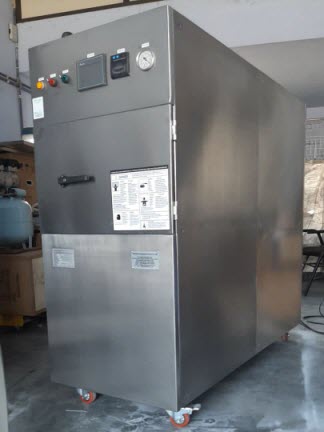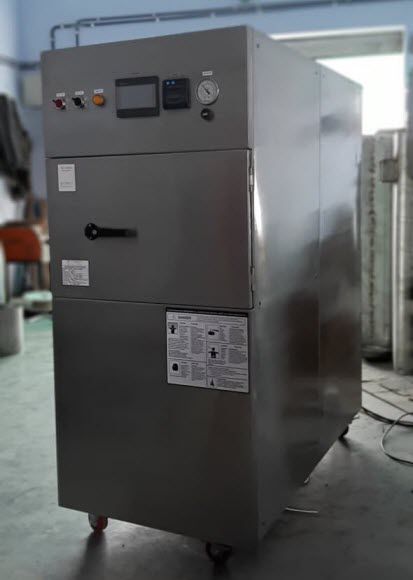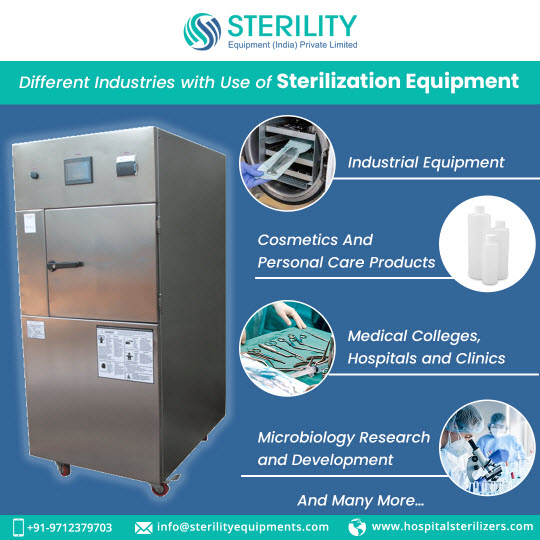The ETO Sterilizer industry in France is currently experiencing robust growth and is a pivotal segment within the country’s healthcare and medical equipment sector. The ETO Sterilizer market in France has witnessed a considerable increase in size and holds immense growth potential. With rising concerns about infection control and a growing emphasis on patient safety, the demand for efficient sterilization technologies has surged. This market analysis provides valuable insights into the current market size and the projected growth, presenting a lucrative opportunity for investors and businesses.
Innovation plays a pivotal role in driving the ETO Sterilizer market forward. Manufacturers are continuously introducing technologically advanced solutions to meet the evolving needs of healthcare facilities. From automated processes to enhanced safety features, this analysis showcases the latest trends and innovations shaping the industry’s progress.
The healthcare sector in France is witnessing an increasing demand for ETO Sterilizers due to the growing number of medical facilities and the need for stringent sterilization processes. These sterilizers play a critical role in ensuring the safety and efficacy of medical instruments, further augmenting their adoption in hospitals, clinics, and other healthcare settings.
Growth Drivers for ETO Sterilizers in France
As medical technology continues to advance, there is a growing reliance on sophisticated and delicate medical equipment. ETO Sterilizers are preferred for their ability to effectively sterilize complex instruments and sensitive devices that cannot withstand high-temperature steam sterilization. The compatibility of ETO Sterilizers with a wide range of medical equipment is driving their popularity in various healthcare settings across France.
France has witnessed a notable expansion in the healthcare sector, with an increasing number of hospitals, clinics, and healthcare facilities being established to cater to the growing population’s medical needs. The need for efficient and reliable sterilization solutions in these facilities is on the rise, boosting the demand for ETO Sterilizers.
Infection control is a paramount concern in healthcare settings, as it directly impacts patient safety and outcomes. ETO Sterilizers offer a high level of efficacy in eradicating microorganisms, including resistant bacteria and viruses, thus ensuring a sterile environment for medical procedures. The emphasis on infection control in healthcare facilities is contributing to the rising demand for ETO Sterilizers.
ETO Sterilizers provide a flexible and efficient sterilization process. Unlike other methods that may damage heat-sensitive equipment, ETO Sterilizers offer a gentle yet effective approach, making them suitable for a wide range of materials and medical instruments. This versatility is a significant driver for their adoption in diverse healthcare applications.

Regulatory Landscape and Compliance
ETO Sterilizers are considered medical devices, and their manufacturing, import, and distribution are governed by the Medical Device Directive (MDD) in France. Manufacturers must obtain the necessary certifications and conform to the MDD’s essential requirements to ensure the quality, safety, and performance of their sterilization equipment.
Before ETO Sterilizers can be marketed and used in healthcare facilities, they must receive approval from the French National Agency for Medicines and Health Products Safety. The French National Agency for Medicines and Health Products Safety evaluates the safety, performance, and quality of medical devices, including ETO Sterilizers, to ensure their conformity with established standards.
ETO Sterilizer manufacturers and healthcare facilities must comply with relevant International Organization for Standardization (ISO) standards. ISO outlines specific requirements for the sterilization of healthcare products using ethylene oxide. Adherence to these standards ensures that the sterilization process is effective and that the equipment is operating at optimal levels.
Manufacturers must prepare comprehensive technical files containing all relevant documentation, including design specifications, risk assessments, and validation reports, to demonstrate the conformity and safety of their ETO Sterilizers. These technical files play a crucial role during the regulatory review process.
To monitor the safety and performance of ETO Sterilizers, manufacturers must establish robust post-market surveillance systems. They are required to promptly report any adverse events or incidents related to their devices to the regulatory authorities, ensuring timely corrective actions if necessary.
Healthcare facilities that utilize ETO Sterilizers must ensure that their staff members receive adequate training in the proper operation and maintenance of the equipment. Staff qualifications and competencies are critical for safe and effective sterilization processes.
Due to the potential environmental impact of ethylene oxide gas, manufacturers and healthcare facilities must adhere to strict regulations on its emissions and waste management. Compliance with these environmental guidelines is essential to minimize the impact on the environment and safeguard public health.
Emerging Trends in ETO Sterilization Technology
Automation is revolutionizing ETO Sterilization processes, streamlining operations, and reducing human intervention. Advanced automated systems allow for precise control of sterilization parameters, ensuring consistent and reliable results. These systems can handle larger volumes of medical equipment, reducing processing time and increasing overall productivity.
Environmental concerns have spurred the development of eco-friendly ETO Sterilization solutions. Newer models feature improved emission control systems, reducing the release of ethylene oxide gas into the atmosphere. Additionally, eco-friendly ETO Sterilizers incorporate advanced filtration and adsorption technologies, minimizing environmental impact while maintaining effective sterilization.
Traditional ETO Sterilization requires high temperatures, which may limit the compatibility of certain materials and medical devices. Emerging trends introduce low-temperature sterilization alternatives, using alternative gases or plasma technology. These methods enable the sterilization of delicate and heat-sensitive instruments, expanding the scope of applications in the healthcare sector.
Enhanced safety measures are a primary focus in ETO Sterilization technology. New systems incorporate sophisticated safety features, such as real-time monitoring of gas concentration, leak detection, and emergency shutdown mechanisms. These safety measures provide an added layer of protection for operators and ensure safe sterilization practices.

Key Applications of ETO Sterilizers in Different Sectors
ETO Sterilizers offer versatile and effective sterilization solutions, finding applications in various sectors where stringent hygiene and safety standards are paramount.
Healthcare Sector
In the healthcare sector, ETO Sterilizers play a crucial role in ensuring the safety and sterility of medical instruments, devices, and equipment. Key applications include:
- Surgical Instruments: ETO Sterilizers are ideal for sterilizing complex and heat-sensitive surgical instruments, including endoscopes, laparoscopic instruments, and robotic surgical tools.
- Medical Devices: Critical medical devices like catheters, implants, and electronic equipment require precise sterilization to prevent infections and ensure optimal functionality.
- Pharmaceuticals: ETO Sterilizers are used to sterilize pharmaceutical products, such as vials, syringes, and stoppers, preserving their integrity and purity.
- Hospital Linens: Textiles, such as surgical gowns, drapes, and linens, are effectively sterilized with ETO to maintain high hygiene standards in healthcare facilities.
Pharmaceuticals Industry
In the pharmaceuticals sector, ETO Sterilizers are essential for maintaining the safety and integrity of products that cannot withstand high-temperature sterilization methods. Applications include:
- Aseptic Filling: ETO Sterilization is utilized to sterilize the primary packaging materials, ensuring aseptic filling of pharmaceutical products like injectables.
- Tubing and Components: ETO Sterilization is employed to sterilize plastic tubing, closures, and other components used in pharmaceutical manufacturing.
- Lab Equipment: Sensitive laboratory equipment and glassware undergo ETO Sterilization to maintain a contamination-free environment.
Food Processing Industry
The food processing industry relies on ETO Sterilizers to ensure the safety and extended shelf life of certain food products. Applications include:
- Spices and Seasonings: ETO Sterilization effectively eliminates pathogens, molds, and insects from spices and seasonings, preserving their quality and flavor.
- Herbs and Botanicals: ETO Sterilization ensures the microbiological safety of dried herbs and botanicals used in various food products.
- Dehydrated Foods: ETO Sterilizers help maintain the quality and safety of dehydrated fruits, vegetables, and meat products.
Cosmetics Industry
In the cosmetics industry, ETO Sterilizers are employed to sterilize products and packaging materials to prevent contamination and ensure product safety. Applications include:
- Packaging Materials: ETO Sterilization is used for sterilizing cosmetic packaging components like bottles, pumps, and caps to maintain product integrity.
- Cosmetic Products: Some cosmetic formulations, particularly those containing sensitive ingredients, are sterilized using ETO to extend their shelf life and prevent microbial growth.
Impact of COVID-19 on the ETO Sterilizer Market
As the pandemic swept across France, healthcare facilities experienced a surge in demand for medical equipment, devices, and PPE. This unprecedented demand placed significant pressure on existing ETO Sterilizers, necessitating rapid and frequent sterilization cycles to maintain infection control. Consequently, the need for efficient and reliable sterilization solutions rose exponentially, leading to increased interest in ETO Sterilizers.
ETO Sterilizers played a pivotal role in sterilizing critical COVID-19 medical equipment, such as respirators, ventilator components, and other respiratory devices. These sterilization processes were vital in ensuring the safety of both healthcare workers and patients, especially during the peak of the pandemic.
The pandemic caused widespread disruptions in global supply chains, affecting the availability of raw materials and essential components for ETO Sterilizers. Manufacturing delays and logistical challenges led to potential shortages of ETO Sterilizers in the market. This disruption further emphasized the need for building resilient and diversified supply chains in the future.
In response to the supply chain disruptions, there was an increased emphasis on local production of ETO Sterilizers to reduce dependence on international suppliers. Manufacturers explored ways to shorten lead times and ensure a steady supply of equipment to meet the rising demand.
To cope with the urgent need for medical equipment during the pandemic, regulatory authorities in France expedited approvals and streamlined processes for ETO Sterilizers and related devices. This allowed faster market entry for new equipment and innovations.
COVID-19 underscored the significance of adherence to strict safety and sterilization standards. Healthcare facilities and manufacturers are now more vigilant about maintaining high hygiene levels, which will continue to bolster the demand for ETO Sterilizers in the post-pandemic era.






